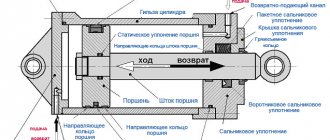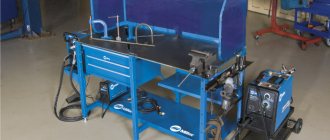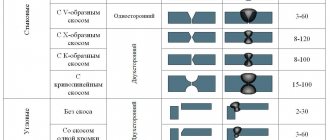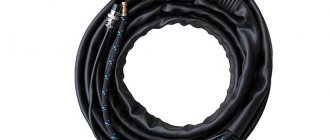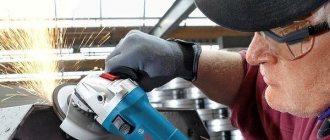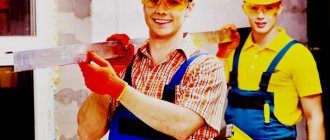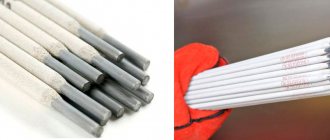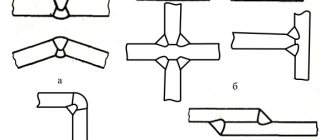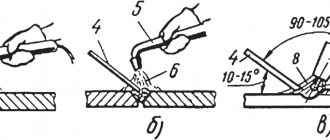Bosch GWS 1000 at work. Photo VseInstruments.ru
The grinder spindle rotates at a frequency of 11,000 rpm. In this case, the peripheral speed of the disk with a diameter of 125 mm. is more than 70 meters per second.
At this speed, hot particles of the material being processed fly out from under the disc of the grinder. In the event of an emergency destruction of the disk, its fragments will “shoot” at the same speed.
Eye hazard
Flying sparks, metal and stone filings, due to their low mass, have insignificant kinetic energy, but sufficient to harm the health of a careless operator.
A large piece of an exploding cutting wheel, in accordance with the law of physics “mass times the square of the velocity divided in half,” can have a kinetic reserve comparable to the muzzle energy of a small-caliber weapon.
A properly installed guard directs the flow of sparks and microparticles away from the operator, instilling a sense of safety, but obstructing visibility and hiding cut marks. Any careful attempt to look behind the casing, any ricocheting fragment - and...
….and the most unpleasant consequences if you are not wearing safety glasses.
Advantages
Chameleon glasses are equipped with two sensors that monitor the light intensity and switch the darkness of the glasses at lightning speed. The delay is half a second; it is impossible to catch a “bunny” in such a short time. The operating principle of fast darkening glasses works on the polarization of liquid crystals under voltage. You can work in them at temperatures from -5 to +55 degrees. The advantages of chameleon glasses are as follows:
- Ease.
- There is no feeling of facial constriction.
- They have ventilation and do not water your eyes.
- Provides good visibility.
- The glass does not fog up.
- Fits tightly to the face.
Welding glasses are ideal for working in hard-to-reach, narrow places where the use of a mask is impossible.
Types of glasses for cutting, grinding and other work with an angle grinder
All devices or products that are attached and worn on the human body, reducing or preventing the impact of hazardous and harmful environmental factors are called personal protective equipment.
Officially produced PPE must comply with GOSTs and international standards , be tested by the manufacturer, have a certificate of conformity and a product passport. Legal entities are prohibited from using products that do not meet these requirements. The employer is obliged to monitor the compliance of his staff with labor protection rules; the inspectorate will always help him with this.
A private individual can protect his health during non-working hours by any means he pleases, but it is better to use reliable, proven, officially manufactured products .
Safety glasses with indirect ventilation of the Zubr brand. Photo 220Volt
Specialized means of protection are provided against each dangerous or harmful factor to health. From falling from a height - PPE(c), for hearing protection - PPE(c) and many others, up to protection from X-ray radiation PPE(r).
First of all, we are interested in eye protection . They are designated – PPE(g).
The list is extensive. We will not consider face shields and screens, open-folding safety glasses, snap-on glasses, visors and protective lorgnettes.
The eye protection necessary for working with an angle grinder is marked indicating its type :
- Open (O);
- Open with side protection (OB);
- Open flaps (OO);
- Closed with direct (DP) and indirect ventilation (IV);
- Closed sealed (G).
There are a lot of varieties of visual surfaces (lenses), they can be made of mineral glass, polymer, clear and painted, hardened, tempered, multi-layered, laminated and chemically resistant. Various coatings can be applied to them to improve their protective properties. Panoramic safety glasses with a flat visual surface and even corrective glasses with diopters are available.
Safety glasses STAYER closed type. Photo 220Volt
If the product uses double glazing, then “D” is added to the marking. For example, open doubles are OD. If there are adjustable temples (earhooks), “P” is added, with an adjustable bridge “P”. Can you imagine a product marked DZNRP, double closed glasses with indirect ventilation, adjustable temples and bridge? These are also produced.
Open and closed
Type O, open design, is the easiest to manufacture and therefore attractive in price . The frame of open glasses does not adhere to the face, providing good ventilation of the “behind the glasses” space and the lenses practically do not fog up from the inside. However, dust or abrasive particles can fly into the “protected area” from any direction except frontal. Therefore, type O products, as having an insufficient level of protection, cannot be recommended for use when working with an angle grinder.
In a professional environment, the most popular protective device is open safety glasses with side protection and adjustable temples, PPE(g) type OBR.
Open type glasses with darkened lenses made of impact-resistant polycarbonate, with top and side protection, SIBRTECH trademark. Photo 220Volt
so-called “glasses for machine operators” are very common, with lenses made of tempered clear glass and adjustable temples (earhooks) , at a relatively low cost.
A reasonable employer will not dress his workers in overalls from Yudashkin, and PPE(g) will also give them inexpensive ones. Open, with side protection and tempered glass lenses.
to the “private” owner of an angle grinder . If he has already bought a fancy, expensive Bosch or Makita, then he wants glasses with all adjustments, with high-quality, sometimes tinted lenses, with multi-purpose coatings on the outer and inner surfaces. They are stored in a special case, with a napkin made of a special material attached to them, which is the only way to wipe them.
Many will appreciate a protective device with autonomous lighting - miniature lights attached to the frame will highlight what your gaze is directed at.
Inforce Style Tech safety glasses with clear lenses. Photo VseInstruments.ru
When working with an angle grinder in a hard-to-reach place or in a cramped space, where the carrying lamp only gets in the way, this function is very useful.
If we take into account the variety of models and options produced, we have to recognize “open with side protection” as a strong candidate for the title of “Most Popular Safety Glasses”.
Let's add:
- The lightest of all similar products, almost not restricting movement.
- The most comfortable , you can take it off and put it on with one hand. Comfortably combines with any headdress.
- Some models are also the most affordable.
Closed safety glasses provide the greatest degree of eye protection during any work involving the scattering of sparks, fragments and microparticles. Indispensable when processing stone, concrete, ceramics and other materials that produce a large amount of suspended dispersed dust that penetrates with air currents into the smallest gaps.
Warning . Exposure to asbestos dust can cause severe eye and respiratory diseases. When processing slate and other asbestos-cement products, additionally use a respirator.
Closed goggles are structurally similar to the masks of divers and snowboarders. They have an elastic belt (braid) or a plastic rim for fastening on the head, with buckles and other devices for adjusting the length. Some designs provide a central belt to prevent slipping.
Safety goggles with direct ventilation ROSOMZ ZP2 PANORAMA super PC 30130. Photo VseInstruments.ru
a soft elastic silicone seal around the perimeter . Some models are entirely made of silicone, with the exception of the visual surface.
The main disadvantage of all type Z models is their high tendency to fog from the inside. The only way to reduce the moisture concentration in the internal volume is ventilation.
The simplest solution is a lot of small holes on the side surfaces of the case to ensure air circulation. Used in glasses type ZP. Despite its apparent simplicity, it reduces the protective properties, allowing the penetration of dust particles. Some products with direct ventilation, included by the manufacturer in the ZP type, can rather be classified as open with side protection.
Safety glasses with indirect ventilation of the Zubr brand. Photo 220Volt
The best protection against dust is provided by closed devices of the ZN type, with indirect ventilation, in the frame of which inserts with labyrinth channels are provided. As air moves, the dust suspended in it settles on the walls of the channels. For cleaning, the ventilation inserts are removed from the case or washed with a stream of water without disassembling the glasses.
Advice. After rinsing with water, wipe with a soft cloth and dry the protective product and its fastening straps thoroughly using a household hair dryer. In any case, the air temperature during drying should not exceed 80-90 degrees.
Closed, sealed goggles of the ZG type are used when working with chemicals in an atmosphere with a high content of harmful substances. When using a hand grinder, you can protect your eyes with them if there are no others at hand.
In addition to increased fogging, closed models have other disadvantages . Increased dimensions and weight, difficulty in dressing and wearing, restriction of movement, difficulty in using with a headdress, need for cleaning (rinsing).
Protective sealed goggles for working with aggressive and non-aggressive liquids ROSOMZ ZNG1 PANORAMA. Photo VseInstruments.ru
All disadvantages are compensated by the high protective properties of closed-type products. When working with increased dust generation, no other types of safety glasses will ensure your safety at this level.
With diopters
Among the variety of eye protection equipment, we note safety glasses with diopters. The most common type of such PPE is OBRP, open with side protection, with optical lenses made of transparent polymer material, adjustable temples and a bridge. In reputable organizations, such PPE is issued to managers and specialists with minor vision loss.
Warning. All personnel of any official enterprise undergo an annual medical examination, the purpose of which is to identify diseases that prevent employees from performing certain types of work. Persons who are required to wear glasses at all times are prohibited from working at heights, welding, and working with hand-held power tools.
If a nearsighted person has to use an angle grinder at home, he needs to purchase an OBRP type with the required diopters.
Safety glasses ROSOMZ O15 HAMMER ACTIVE super PC open type with diopters. Photo All Tools
Some advisors suggest using inexpensive glasses purchased at a pharmacy with lenses made of polymer material. Those giving such advice are quite erudite and know that corrective glasses with tempered lenses are not available.
Please take into account. Using regular optical glasses as safety glasses puts your safety at risk. They do not meet the standards and technical requirements and are not personal eye protection.
Good advice. If your vision does not allow you to work with an angle grinder, and the delivery of the ordered product with diopters is delayed, put on contact lenses, protect your eyes with any model of PPE (g) and calmly pick up an angle grinder.
Anti-fog safety glasses
Any glasses and masks fog up due to the fact that their internal surfaces are exposed to the heat of the body surface, to which is added heat from breathing that penetrates under the glasses, on the outside of which the air temperature is lower. The exhaled air contains water vapor; the moisture content of the skin is higher than the humidity of the surrounding air. When warm air comes into contact with the colder surface of the glasses, water vapor condenses and the condensation settles on the lenses, reducing their transparency and making it difficult to see.
Let's remember physics . The dew point, at constant atmospheric pressure, is the temperature of the air at which the water vapor it contains begins to condense.
Completely eliminating the condensation of water vapor in a local volume when there is a temperature difference between inside and outside is a rather difficult task . It was successfully solved only when creating helmets for astronauts and high-altitude aviation pilots.
Protective closed glasses ROSOMZ. The glass is coated with an anti-fog, super-durable and water-insoluble coating. Photo VseInstruments.ru
Non-fogging , that is, non-wettable hydrophobic materials have long been widely known . These are fluoroplastic, Teflon and others. The trouble is that most of them are not transparent and therefore not suitable for making glasses.
The only solution for manufacturers of protective equipment is to apply a water-repellent coating to the inner surface.
If you come across a product advertised as “anti-fog”, do not trust these words.
Take care of the protective layer, its thickness is measured in several microns. When wiping a foggy surface, it is easy to damage the coating for which you paid so much. Care for your glasses in strict accordance with the attached instructions and never use solvents.
Folk tricks against fogging
You can make the surface of plastic or glass yourself non-fogging and hydrophobic. The advice is simple - you need to apply a non-wettable coating. It is highly desirable that the coating be as transparent, colorless as possible and does not cause color aberration (distortion).
If you want to waste time in vain, type in a search engine “how to protect windows from fogging.” You will find a lot of advice, including useless and even harmful.
There are few practical, proven tips that actually work.
- First. This does not apply to folk tricks. Lasts for a very long time. Use a special “pencil” from a military gas mask. Options - a similar accessory from the breathing apparatus used by the Ministry of Emergency Situations. You can order online or buy in a specialty store.
- Second. Apply a drop or two of car polish to the surface to be protected. Rub and polish with a cosmetic wipe. Wax polish on a car can withstand 2-3 washes - under high pressure and using a special shampoo (!). Silicone polish lasts longer, polymer polish lasts a very long time.
For the skeptics. Waxy eye polish is completely harmless. The other two are harmless after polymerization, after 3-5 minutes.
- Third . One-time measure. Apply a few strokes of dry soap to the visual surfaces. Rub and polish with a cloth.
In any case, the surfaces to be protected must be clean and dry.
Material: glass (transparent), plastic, silicone, polymer
The so-called “glasses for machine operators” are widely known, the visual surfaces of which are made of tempered colorless glass. The passport for such products says: “for grinding, drilling, milling, turning, installation, plumbing and other work related to the processing of metals, stone, plastics, wood and other materials.”
There are many advantages. Tempered glass lenses are least susceptible to abrasion, scratching, abrasives, solvents, splashes and metal sparks, and are resistant to high temperatures.
There is one drawback, but a decisive one. When any glass, even tempered glass, breaks, dangerous fragments are formed.
Closed safety glasses with direct ventilation SPEC ZP2, lens material - plexiglass. Photo VseInstruments.ru
Making lenses using triplex technology, from two layers of glass with transparent plastic in between, does not solve the problem of small fragments.
Polymer materials have long occupied advanced positions in optics.
Celluloid , invented in 1855, was used as an optically transparent material until 2014, when it was banned due to its high fire hazard. Thrifty users still have “pilot” glasses.
AMPARO safety glasses, lenses made of polycarbonate. Photo 220Volt
Plexiglas , born in 1928, also known as Acrylic , also known as Plexiglas , is still successfully used in many industries, including in aviation and medicine precisely as a material for transparent surfaces. It has high strength and does not splinter when broken. Disadvantage: low resistance to scratches, chemicals and solvents.
ADC plastic , or CR -39 , is one of the best types of optical plastic. Most resistant to abrasion and scratches, not subject to aging and “material fatigue”. Twice lighter than tempered mineral glass. Does not react with most chemicals. Disadvantage: expensive.
Safety glasses FIT 12225 with plastic lenses. Photo 220Volt
Polycarbonate , its transparent varieties. The most common optical polymer. Elastic, elastic , perfectly resists shock loads.
Disadvantages: low surface hardness, tendency to rubbing and clouding under the influence of microparticles. Easily scratched. Under the influence of solar UV radiation, transparency deteriorates and becomes brittle.
To produce high-quality products, it is necessary to apply protective coatings to protect the surface from scratches and wear.
Advantage : cheap. (Protective coatings increase the cost of the finished product.)
Silicone is a very inexpensive optical material. Easy to manufacture, perfectly molded at low temperatures. The advantages are the same as those of polycarbonate. Disadvantage: low adhesive properties make coating application difficult.
Important. Any polymers used in the manufacture of optical and safety glasses must have hypoallergenic properties.
Requirements for glasses for gas cutting
When working with an autogen, the human eye is exposed to two types of radiation - visible and ultraviolet, and the latter poses the greatest danger. Coupled with exposure to noise, the release of dust, gases and sparks, it can lead to negative consequences, including loss of vision. Therefore, the following design requirements are imposed on glasses for gas cutters:
- the material must be durable and light;
- when worn, the attribute provides a wide visual field;
- should not fog up;
- the light filter operates on the principle of automatic dimming (immediately when a light arc appears);
- Ventilation of the area around the eyes is encouraged.
The body of good glasses is made of plastic or light metal. There are ventilation holes between the belt and the lenses, and the built-in filters should protect against splashes of hot metal.
In addition to design requirements, it is worth knowing about the compliance of glasses with certain regulatory documents. For example, OSHA standard or European EN 166, EN 169 and EN 175. Some models are DIN marked if they meet the requirements. All markings can be found on the frame of the glasses, on the lenses, or in both places.
Rating (top) of the best glasses, list of brands: 3M, UVEX, Interskol and others
One of the leaders in the production of protective optics is the German company UVEX . Its products provide maximum eye protection and comfortable wearing. Everything is taken into account: the distance between the centers of the pupils, the shape of the head, the face. Wide selection of coatings for various working conditions. All models supplied to Russia are named in Russian transliteration. For example, UVEX Ultravision Safety Glasses.
Uvex Ultravision goggles with anti-fog coating. Photo VseInstruments.ru
The American company 3M ( Minnesota Mining and Manufacturing Company is very famous . Its products have the highest safety rating. Some models are able to withstand without destruction the impact of a steel ball with a diameter of 6.35 mm flying at a speed of 45 meters per second. The materials used are CR-39 plastic and polycarbonate with high-quality anti-wear and water-repellent coatings.
Personal protective equipment is produced under the brands Peltor, Pyramex, SpeedGlass, SecureFit.
Interskol occupies a worthy position in the long list of manufacturers of protective equipment The company's extensive catalog includes a variety of closed and open glasses, adjustable and fixed models, with color variations, in a wide range of prices. The most advanced technologies, including licensed ones, are used in production. Interskol products attract with their reliability and reasonable prices.
Each master has the opportunity to express his own opinion regarding the best brand. Below is a list of brands for which you can vote; leaving a comment will allow you to explain your point of view.
If you think that we have undeservedly missed out on a brand, write to us in the comments, we will add it to the survey.
Welding helmet with ASF "Chameleon"
The welding helmet has all the advantages of glasses. The design of modern welder protection is such that it is firmly attached to the head and protects it, leaving the hands free to perform production operations. There is a lot of free space under the mask, which provides good ventilation and creates comfortable working conditions. An overview of the working area is provided by a wide-format liquid crystal light filter (LCF), which darkens when the welding arc is ignited in thousandths of a second and in a very short time (with a delay for the weld pool to cool) becomes clear when it fades. In a welding helmet, you can weld a seam of any location (lower, upper, vertical in both directions, etc.).
As an example, you can get acquainted with a welding helmet of this type in the article “Welder mask “ELITECH MS 500-1”, which, in addition, has the option of “spark anti-darkening” (it turns off and does not react to sparks during abrasive metal processing).
If it is necessary to carry out welding work in rooms without ventilation with a dirty atmosphere, the use of welding glasses is impossible. In this case, welding masks with an air supply unit are used.
This welder protection kit is discussed in the article “Welding mask “SVAROG AS-4001F” with air supply unit P-1000.” You can get acquainted with other models of welding helmets if you use the “Site Search” service.
A welding helmet with ASF is, of course, more expensive than goggles, but it also has more capabilities to protect your health. Before purchasing equipment, you should “weigh”: will you make a mistake by buying relatively cheap welding glasses?
Which ones are better, how to choose
To choose the right eye protection, you need to clearly understand you will use it for the degree of danger of these works , know the markings and the desired qualities of the product - viewing angle, the ability to adjust the arms or strap, the transparency of the lenses and its safety during long-term use, resistance to scratches and other defects.
Useful video
A short video where a person shares his opinion and advice on choosing.
Consultation with a qualified seller is urgently needed.
Don’t trust smart managers who sell everything from a walk-behind tractor to a screwdriver.
Open safety glasses SecureFit 201 with 3M transparent lenses. Photo VseInstruments.ru
Don’t forget that the store is also called “specialized” because it employs specialists.
Please note that you will not always be allowed to try on the models you like one after another; pay attention to the brand and manufacturer of the product.
Remember. The cheapest product is not always the best.
Don't skimp on protecting your eyes.
Purpose of safety glasses
In addition to the danger of electric shock and injury from rotating elements, when handling an angle grinder, you must be careful of getting all sorts of objects into your eyes. Retinal burns, which can be caused by a hot spark, are quite serious injuries and require medical attention.
Clouds of dust and dirt cause irritation of the mucous membrane and cause eye fatigue. Injuries from sharp shrapnel are common. Any damage to the visual organs or skin is considered an industrial injury. That is why glasses and protective masks for angle grinders are mandatory for use with this and similar devices.
Don't look at the bright light!
Eye protection during plasma cutting is a question that interests many. Let's look at the problem in more detail. When cutting, a plasma arc, like any electric arc, emits a wide range of electromagnetic radiation, which goes all the way: from infrared light (passing through the visible spectrum) to its ultraviolet range. The electric current during plasma cutting can be very intense, ranging from 100 to 800 Amperes. It goes without saying that looking at the arc can easily cause eye damage. If a worker's retina is exposed to bright light for a long time, the consequences may be more serious. How to avoid this?
Recommended eye protection for plasma cutting
There are several important, good sources that have standards and recommendations that any good welder should know. These include OSHA and ANSI standards, as well as OST 5.9823-80 “Electric welding works. Safety requirements".
Let's consider foreign standards. OSHA is the US Federal Occupational Safety and Health Agency. Their fact sheet, “Protecting Eyes from Radiant Energy During Welding and Cutting in Shipbuilding Operations,” has guidelines for welder eye protection citing data from ANSI (American National Standards Institute). The eclipse degree numbers refer to safety glasses or welding helmets. The higher the number, the darker the glass.
ANSI and the American Welding Society (AWS) have published an even more detailed table, “Safety in Welding, Cutting, and Related Processes (ANSI Z49.1: 2005).”
In both cases, the guidelines suggest a rule of thumb: “Start with the shade that is darkest to show the weld area. Then we move to a lighter shade that gives enough representation of the welding area without going below the minimum.”
ANSI recommendations for SMAW, GMAW and FCAW welding are in the shade range with shade number 10 - 14. How does this apply to a welding operation? When welding, you basically stand and look at the welding area through your helmet as usual, and you can manually operate the welding torch, which is just a few centimeters from your face.
But the operation of a CNC machine is slightly different:
- the operator is much more likely to be further away from the arc;
- the welder must move around, so he must be able to clearly see his surroundings (this is relatively dangerous in a welding helmet);
- the operator must have visual ability to control the machine while the arc is on;
- The welding arc moves, so the operator will not always be able to see in its direction.
Features of operation and care
When using protective products, it is important to follow certain rules. It is important to inspect the glasses before starting work. During the visual assessment, the reliability of the fastenings is checked. Some models of personal protective equipment require treatment of the inside with specialized compounds that prevent rapid fogging. This often refers to closed-type equipment without side or direct ventilation. After these steps, you should “adjust” the product to the size of your head by adjusting the length of the belt or adjusting the angle of the arms.
Upon completion of work, wipe the glasses with a damp cloth to remove dirt, dust, metal or wood shavings. For these purposes, you can pre-purchase material impregnated with a specialized composition for disinfecting the surface of PPE. Wiped and dried ammunition is placed in a storage case. If these recommendations are followed, the products will last a long time while maintaining their effectiveness.

